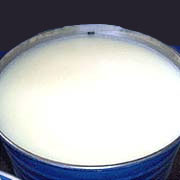
As I have already written in our previous blog, in this occasion we will enumerate processes in those white oils are used, being two the mainly ones:
• as heat transfer fluid in installations in those the final products are for direct human consumption ,
• as an oleic base of a final product that will be used directly by humans, and which we consider medicinal white oils.
In relation to the first topic, it is recommended the use of the white oils as heat transfer fluids in the installation of thermal fluid heaters, when the last ones are used with reactors, friers or equipments able to produce pharmaceutical products, food, etc., in order to avoid the alteration of the final product of human consumption during the production process, because of an accidental leak of a toxic thermal fluid.
According to the information that we have found, we think that there are two types of white fluids: the medicinal ones (base of products) and those used as heat transfers, both with low toxicity. If some reader agrees with the present statement, please confirm!!!!
In reference to the second subject, hereby we include a list of products in which medicinal white oils are present as base component:
Preparation of cosmetics:
- Cream, sun lotions and milks, ointments, paper impregnation, etc.
- Softening and moisturizers (oils and cleaner milks, lipsticks, powdered make-up);
- Products for children (shampoos and bathroom oils);
- Products for the hair care;
- As protective and neuter diluter for other ingredients of cosmetics, as essential oils; as anti-perspirants and deodorants in bar.
For their use in the food industry are added inhibitors of the corrosion:
- Unmolding in bakery products and pastries,
- Frying potatoes or chips, fruits as peanuts, etc… and ready or pre-cooked meals.
- Also used in treatment of rice,
- Emulsified oils for jams,
- Packaging of fruits,
- Conservation of eggs.
In the pharmaceutical industry, it has a high level of security due to:
- Their maximum purity (absence of toxic aromatic polyciclics and heavy metals),
- The complete destruction of germs in the process of production at high temperature,
- Used in specific procedures of packaging and manipulation: ingredients of the pharmaceutical ointments of topic use and petroleum jellies.
- It can be used as auxiliary element in the production of pills and in the production of capsules of jelly. The white medicinal oil is used in laxatives and liquid vaselines.
The white medicinal oils should satisfy the requirements of the regulation FDA defined in the clause 21 CFR 172.878 of the U.S.P. (USA), D.A.B. (Germany), B.P. (United Kingdom), CODEX (France) and Spanish Pharmacopea.
Read More!
• as heat transfer fluid in installations in those the final products are for direct human consumption ,
• as an oleic base of a final product that will be used directly by humans, and which we consider medicinal white oils.
In relation to the first topic, it is recommended the use of the white oils as heat transfer fluids in the installation of thermal fluid heaters, when the last ones are used with reactors, friers or equipments able to produce pharmaceutical products, food, etc., in order to avoid the alteration of the final product of human consumption during the production process, because of an accidental leak of a toxic thermal fluid.
According to the information that we have found, we think that there are two types of white fluids: the medicinal ones (base of products) and those used as heat transfers, both with low toxicity. If some reader agrees with the present statement, please confirm!!!!
In reference to the second subject, hereby we include a list of products in which medicinal white oils are present as base component:
Preparation of cosmetics:
- Cream, sun lotions and milks, ointments, paper impregnation, etc.
- Softening and moisturizers (oils and cleaner milks, lipsticks, powdered make-up);
- Products for children (shampoos and bathroom oils);
- Products for the hair care;
- As protective and neuter diluter for other ingredients of cosmetics, as essential oils; as anti-perspirants and deodorants in bar.
For their use in the food industry are added inhibitors of the corrosion:
- Unmolding in bakery products and pastries,
- Frying potatoes or chips, fruits as peanuts, etc… and ready or pre-cooked meals.
- Also used in treatment of rice,
- Emulsified oils for jams,
- Packaging of fruits,
- Conservation of eggs.
In the pharmaceutical industry, it has a high level of security due to:
- Their maximum purity (absence of toxic aromatic polyciclics and heavy metals),
- The complete destruction of germs in the process of production at high temperature,
- Used in specific procedures of packaging and manipulation: ingredients of the pharmaceutical ointments of topic use and petroleum jellies.
- It can be used as auxiliary element in the production of pills and in the production of capsules of jelly. The white medicinal oil is used in laxatives and liquid vaselines.
The white medicinal oils should satisfy the requirements of the regulation FDA defined in the clause 21 CFR 172.878 of the U.S.P. (USA), D.A.B. (Germany), B.P. (United Kingdom), CODEX (France) and Spanish Pharmacopea.




